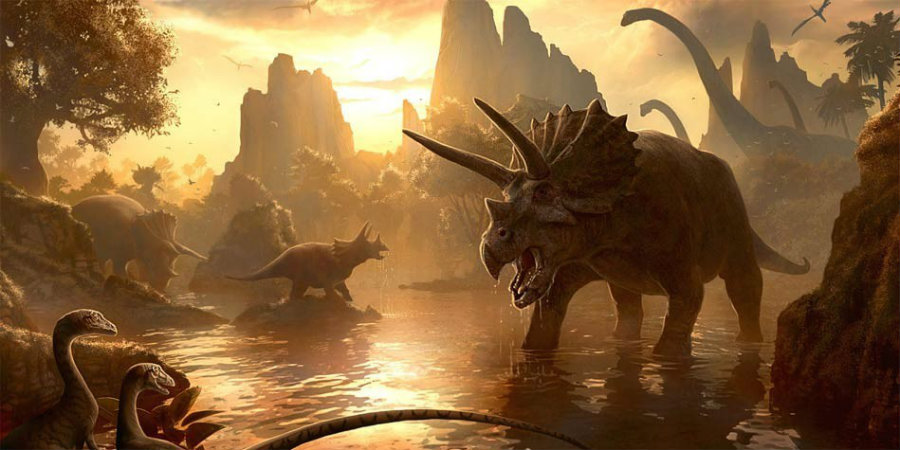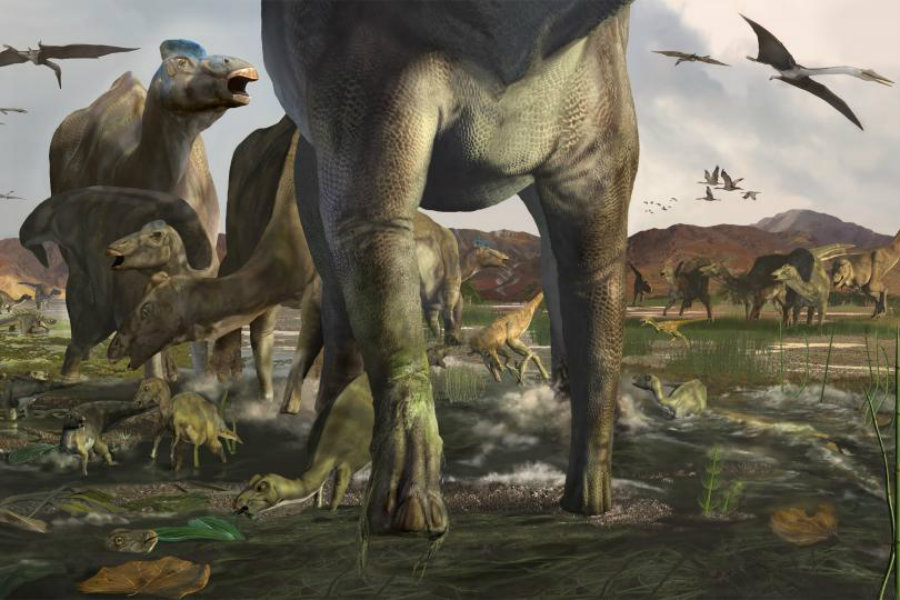By examining recently discovered coprolite deposits, paleontologists found that herbivorous dinosaurs ate crustaceans and rotten wood predigested by fungi. This occasional diet was a source of animal protein and calcium, which the giant animals needed in the breeding season, according to a paper published Thursday in the journal Scientific Reports.
Found in the Kaiparowits Formation of Grand Staircase-Escalante National Monument in southern Utah, this new evidence is ~860 m thick and was deposited between ~76.0 and 74.1 million years ago.

It is not yet clear what crustaceans these were, but they could have been crayfish or marine crabs. The researchers were surprised by these odd feeding habits given that large plant-eating dinosaurs were thought to have had a rigorous diet based on the idea that their derived teeth and jaws only allowed them to process fibrous plant foods.
The sedimentary package may have been produced by the larger bodied hadrosaurs and ceratopsians given their multi-toothed dental batteries, the paper says. Of these two, the hadrosaur is the best candidate because of its dentition’s crushing and shearing abilities, which may have allowed it to eat more the just plants.
Inside fossil feces
Karen Chin, paleontology curator at the University Of Colorado Museum Of Natural History in Boulder, conducted the study alongside Rodney Feldmann and Jessica Tashman, who both are paleontologist of Kent State University. The team of researchers examined the sizeable woody fecal masses and found that at least 10 of 15 coprolite deposits contained pieces of dark, shell-like material, which comprised up to 5% of coprolite specimens.
The crustaceans eaten by the dinosaurs used to shelter in rotting logs and most of the content found in the fossilized feces was composed of wood tissues that were rotted by fungus before ingestion. The fossilized wood contained in the coprolite deposits was not very surprising to researchers because Chin found similar evidence a decade ago in the Two Medicine rock formation in Montana.
The finding was very odd at the time since most vertebrate animals are unable to digest wood due to its tough binding molecules. The paleontologist at first thought that dinosaurs were eating it by accident as they munched on short foliage such as juniper or cedar needles. She then realized that there were too many wood pieces and little evidence of chewed-up twigs, which suggested that the giant beats actually liked to eat decayed wood.
Paul Barrett, a paleontologist at the Natural History Museum in London, said it was very rare to find evidence of herbivorous dinosaurs supplementing their diet with different alternatives, as reported by Scientific American.

The herbivore dinosaurs may have been dumb and eaten anything on their way, Chin suggested, according to a report by The Washington Post. Another possibility she offered is that they selectively hunted exactly what they needed, but the third one seems more plausible to her. The animals probably happened to graze where crustaceans found shelter and rotten wood may have been their primary target as a seasonal meal.
Nevertheless, the dinosaurs also seemed to like eating crustaceans because the pieces found in the coprolite deposits were too big to be ingested by accident, according to Chin. If they only intended to eat rotten wood, they would have been able to avoid or spit out the animals.
The dinosaurs’ oviparous breeding activities may have included certain changes in their dietary habits, which explains why they did not eat crustaceans and rotten wood during the whole year. In the paper, the team of researchers suggests that the dietary flexibility of herbivorous dinosaurs is similar to that of modern herbivorous birds, which ingest more protein and calcium during the breeding season.
The researchers affirm in the paper that the evidence reminds the scientific community that megaherbivorous dinosaurs do not have modern analogs but studying their dietary habits can help paleontologists to understand today’s organisms better.
About Karen Chin
“We are living in a snapshot of life through time. Understanding more about the past — and that includes dinosaurs and other kinds of prehistoric animals — helps us evaluate our place in the ecosystem,” Chin said, as quoted by The Washington Post. “There’s still a lot we don’t know about modern life.”
Chin is particularly interested in insights fossil feces can provide about the paleobiology of dinosaurs and feeding habits in extinct animals. She is engaged in a field program in the Rocky Mountain region, and her job includes teaching undergraduate and graduate students. The expert in coprolites oversees the trace fossil and fossil eggshell collections at the University Of Colorado Museum Of Natural History.
The paleontologist explained in an interview with the National Park Service that fossil feces are very hard to study because an animal first digested the food and then suffered geologic alteration throughout millions of years. Moreover, many fossilized feces are not preserved enough to provide significant insights, but those well-preserved samples can allow scientists to discover evidence about ancient ecosystems that is not available by studying bones or shells.
Source: Nature
